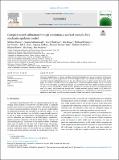Files in this item
Complex model calibration through emulation, a worked example for a stochastic epidemic model
Item metadata
| dc.contributor.author | Dunne, Michael | |
| dc.contributor.author | Mohammadi, Hossein | |
| dc.contributor.author | Challenor, Peter | |
| dc.contributor.author | Borgo, Rita | |
| dc.contributor.author | Porphyre, Thibaud | |
| dc.contributor.author | Vernon, Ian | |
| dc.contributor.author | Firat, Elif E. | |
| dc.contributor.author | Turkay, Cagatay | |
| dc.contributor.author | Torsney-Weir, Thomas | |
| dc.contributor.author | Goldstein, Michael | |
| dc.contributor.author | Reeve, Richard | |
| dc.contributor.author | Fang, Hui | |
| dc.contributor.author | Swallow, Ben | |
| dc.date.accessioned | 2022-09-28T11:30:16Z | |
| dc.date.available | 2022-09-28T11:30:16Z | |
| dc.date.issued | 2022-06-01 | |
| dc.identifier | 281140372 | |
| dc.identifier | 9a9baf15-8420-40fe-bcd8-928135b17bea | |
| dc.identifier | 000805050100001 | |
| dc.identifier | 85130609388 | |
| dc.identifier.citation | Dunne , M , Mohammadi , H , Challenor , P , Borgo , R , Porphyre , T , Vernon , I , Firat , E E , Turkay , C , Torsney-Weir , T , Goldstein , M , Reeve , R , Fang , H & Swallow , B 2022 , ' Complex model calibration through emulation, a worked example for a stochastic epidemic model ' , Epidemics , vol. 39 , 100574 . https://doi.org/10.1016/j.epidem.2022.100574 | en |
| dc.identifier.issn | 1755-4365 | |
| dc.identifier.other | ORCID: /0000-0002-0227-2160/work/118411950 | |
| dc.identifier.other | PubMedCentral: PMC9109972 | |
| dc.identifier.uri | https://hdl.handle.net/10023/26084 | |
| dc.description | Funding: This work was supported by EPSRC, United Kingdom grant no. EP/R014604/1. RR was funded by STFC, United Kingdom grant no ST/V006126/1. IV gratefully acknowledges Wellcome funding (218261/Z/19/Z) and EPSRC funding (EP W011956). TP gratefully acknowledges funding from the Scottish Government Rural and Environment Science and Analytical Services Division, United Kingdom, as part of the Centre of Expertise on Animal Disease Outbreaks (EPIC). TP would also like to thank the French National Research Agency and Boehringer Ingelheim Animal Health France for support through the IDEXLYON project (ANR-16-IDEX-0005) and the Industrial Chair in Veterinary Public Health, as part of the VPH Hub in Lyon. | en |
| dc.description.abstract | Uncertainty quantification is a formal paradigm of statistical estimation that aims to account for all uncertain-ties inherent in the modelling process of real-world complex systems. The methods are directly applicable to stochastic models in epidemiology, however they have thus far not been widely used in this context. In this paper, we provide a tutorial on uncertainty quantification of stochastic epidemic models, aiming to facilitate the use of the uncertainty quantification paradigm for practitioners with other complex stochastic simulators of applied systems. We provide a formal workflow including the important decisions and considerations that need to be taken, and illustrate the methods over a simple stochastic epidemic model of UK SARS-CoV-2 transmission and patient outcome. We also present new approaches to visualisation of outputs from sensitivity analyses and uncertainty quantification more generally in high input and/or output dimensions. | |
| dc.format.extent | 13 | |
| dc.format.extent | 2095129 | |
| dc.language.iso | eng | |
| dc.relation.ispartof | Epidemics | en |
| dc.subject | Uncertainty quantification | en |
| dc.subject | History matching | en |
| dc.subject | Stochastic epidemic model | en |
| dc.subject | SEIR | en |
| dc.subject | Calibration | en |
| dc.subject | Covid-19 | en |
| dc.subject | QA75 Electronic computers. Computer science | en |
| dc.subject | RA0421 Public health. Hygiene. Preventive Medicine | en |
| dc.subject | T-NDAS | en |
| dc.subject | SDG 3 - Good Health and Well-being | en |
| dc.subject | MCC | en |
| dc.subject.lcc | QA75 | en |
| dc.subject.lcc | RA0421 | en |
| dc.title | Complex model calibration through emulation, a worked example for a stochastic epidemic model | en |
| dc.type | Journal article | en |
| dc.contributor.institution | University of St Andrews. School of Mathematics and Statistics | en |
| dc.contributor.institution | University of St Andrews. Centre for Research into Ecological & Environmental Modelling | en |
| dc.identifier.doi | https://doi.org/10.1016/j.epidem.2022.100574 | |
| dc.description.status | Peer reviewed | en |
This item appears in the following Collection(s)
Items in the St Andrews Research Repository are protected by copyright, with all rights reserved, unless otherwise indicated.

